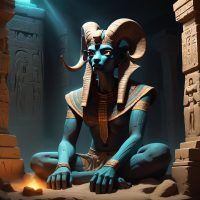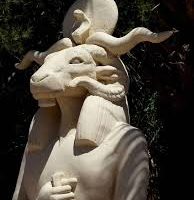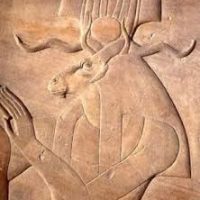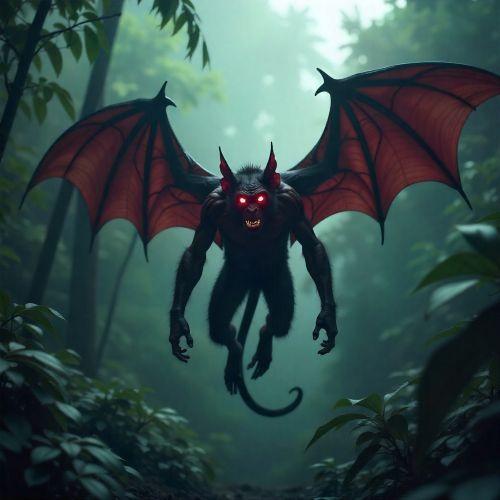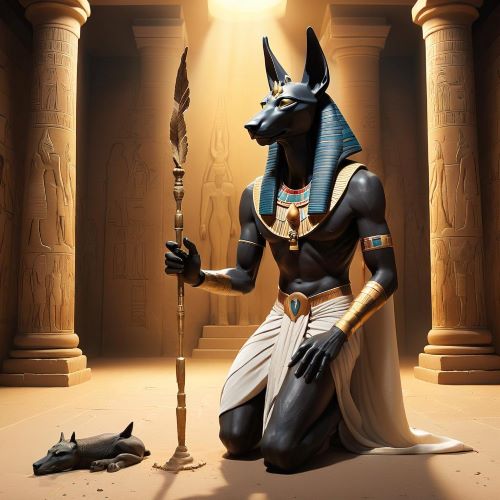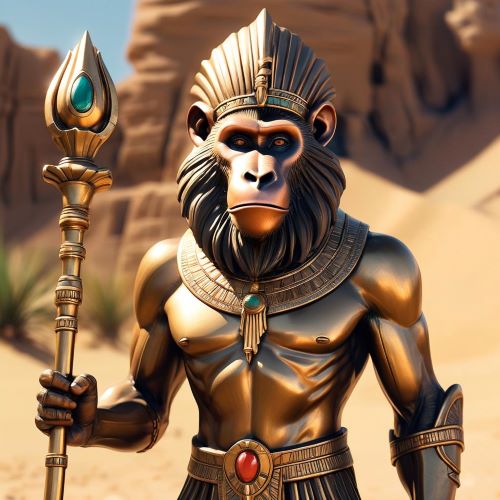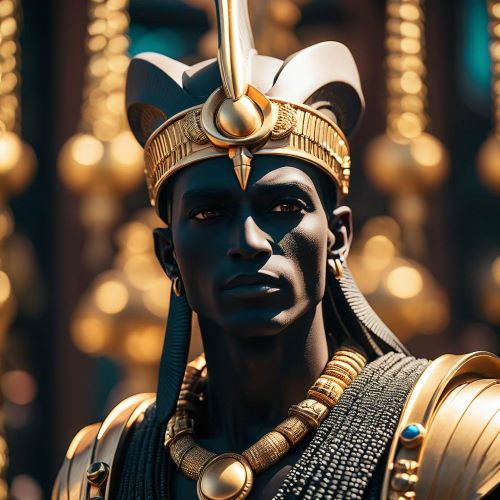Kherty : The Underworld Guide
Listen
At a glance
| Description | |
|---|---|
| Origin | Egyptian Mythology |
| Classification | Gods |
| Family Members | N/A |
| Region | Egypt |
| Associated With | Underworld |
Kherty
Introduction
Kherty is one of the most enigmatic deities in ancient Egyptian mythology, known primarily as a guardian and guide of the Duat, the Egyptian underworld. His earliest mentions appear in the Pyramid Texts of the Old Kingdom, dating back to the 6th Dynasty, though evidence of his worship may extend to the 2nd Dynasty. Often overshadowed by deities like Osiris and Anubis, Kherty occupied a unique position within the Egyptian pantheon as both a psychopomp—the one who ferries souls through the afterlife—and a harbinger of death. His name is believed to derive from the Egyptian root meaning “to slaughter,” an indication of his dual nature: a protector who ensured safe passage for the dead, and a destroyer capable of striking down the living by seizing their hearts. This ambivalence reflects the Egyptians’ deep awareness of the delicate balance between life, death, and rebirth.
Kherty’s prominence in funerary literature underscores his importance in early Egyptian religion. In the Pyramid Texts, he appears as both a threat and a protector of the deceased king, symbolizing the precarious journey of the soul through the afterlife. His cult was particularly active in Letopolis (modern-day Ausim), where he was venerated as a guardian deity who presided over the boundaries between worlds.
Physical Traits
Kherty is most often depicted as a recumbent, mummified ram—a powerful symbol of fertility, regeneration, and strength. The ram was sacred in Egyptian iconography, embodying protective and creative forces, and Kherty’s form as a ram underscored his dominion over death and renewal. In some representations, he appears as a ram-headed man, emphasizing his hybrid nature that bridges divine power and earthly existence. Occasionally, Kherty was also shown as a lion or bull, animals that further highlighted his associations with vitality, authority, and guardianship.
The hieroglyphs for Kherty’s name feature the shamble and the loaf of bread, together forming his phonetic spelling. These symbols evoke sustenance and ritual offerings, suggesting his connection to the eternal exchange between the living and the dead. Artistic depictions in tombs and temple walls often portray him in a protective pose, as if watching over the deceased during their perilous voyage through the Duat.
Family
Unlike many of the better-known Egyptian gods, Kherty does not have a clearly defined family lineage. There are no surviving myths detailing a consort, offspring, or divine parentage, which reinforces his image as a solitary and liminal being. Nonetheless, he is often linked to major gods such as Ra and Osiris, both of whom shared responsibilities related to death and resurrection.
In the Pyramid Texts, Ra is described as intervening to shield the pharaoh’s soul from Kherty’s harmful side, suggesting that while Kherty’s duties were vital, they were also potentially dangerous. His relationship with Osiris, the ruler of the underworld, is equally significant: Osiris governed judgment and rebirth, while Kherty managed the passage between life and death. Over time, Kherty’s functions began to overlap with other underworld deities like Aker, who guarded the gates of the Duat. This merging of attributes suggests that Kherty’s role evolved alongside Egypt’s shifting religious focus from the Old Kingdom to the Middle Kingdom.
Other names
Kherty’s name appears in several forms, including Cherti, Khartey, and Kherty-Khem. The variation “Cherti” translates roughly as “the subservient one” or “the lower one,” a reference to his dominion over the underworld. Another epithet, Khenty-Khem, means “Foremost of Khem,” linking him to the city of Letopolis, his primary cult center.
Interestingly, some texts refer to Kherty as Khenty n irty—“the one without eyes”—a title that emphasizes his mysterious and paradoxical nature. This description may symbolize spiritual blindness or transcendence, as deities without physical sight were often believed to perceive the divine truth beyond mortal vision. His alternative titles, such as “He Who Is Before the Box,” likely refer to his role as guardian of the sarcophagus and the gatekeeper to the afterlife.
Powers and Abilities
Kherty’s powers centered around his dominion over the threshold between life and death. He was the ferryman of the dead, guiding souls across the treacherous terrain of the Duat aboard his divine boat, Meseket. This role was not merely symbolic—ancient Egyptians believed that Kherty’s ferry was essential for transporting the soul to its judgment before Osiris. Without his aid, the soul risked being lost in the darkness of the underworld.
Paradoxically, Kherty was also feared as a bringer of death. The Pyramid Texts describe him as one who “lives on the hearts of men,” implying that he could cause death by taking possession of the heart—the seat of life and emotion in Egyptian belief. This duality made Kherty both a protector and a destroyer, a being who could safeguard or slay depending on divine will.
To ensure his benevolence, the Egyptians performed prayers and offerings to appease Kherty. In some funerary spells, he is implored to spare the deceased and instead act as their guide. His connection to the ram further reinforced his symbolic role in cycles of death and rebirth, as rams represented renewal and fertility. Over time, his functions were partially inherited by other deities like Aker and Aken, who continued his role as ferrymen in later funerary texts such as the Coffin Texts and the Book of the Dead.
Modern Day Influence
While Kherty is not as widely recognized as major Egyptian gods like Osiris, Anubis, or Ra, his legacy persists through his archetype as a psychopomp—the divine ferryman who escorts souls into the afterlife. This archetype appears across cultures, from Charon in Greek mythology to the Grim Reaper in European folklore. Kherty’s image as a deity who both protects and destroys has inspired scholars, artists, and mythologists seeking to explore the ancient Egyptian concept of duality in divinity.
Modern Egyptological studies regard Kherty as one of the earliest representations of the liminal gods—deities who dwell between opposing forces such as life and death, light and darkness. His portrayal in the Pyramid Texts continues to inform contemporary understandings of early Egyptian funerary practices and theology. Exhibitions in museums occasionally feature Kherty’s iconography to illustrate the evolution of Egyptian beliefs about the soul’s journey after death.
In literature, visual media, and online mythology projects, Kherty has found new life as a mysterious and introspective symbol of transition. Digital artists often reimagine him as a spectral ram-headed guardian or a shadowy figure presiding over the boundary between worlds. His mythology speaks to timeless human concerns about mortality, judgment, and the hope for renewal beyond death.
Ultimately, Kherty embodies one of the most profound aspects of Egyptian spirituality—the acknowledgment that creation and destruction, protection and peril, are inseparable facets of existence. Though time has obscured much of his cult and worship, Kherty remains a compelling reminder of how the ancient Egyptians sought to reconcile fear and faith in their understanding of the afterlife.
Related Images
Source
Wikipedia. (2023). Kherty. Retrieved from https://en.wikipedia.org/wiki/Kherty
Ancient Egypt Online. (2023). Kherty (or Cherti). Retrieved from https://ancientegyptonline.co.uk/kherty
Scribd. (2025). Kherty (Neter) | Ancient Egyptian Religion. Retrieved from https://www.scribd.com/document/343388092/Kherty-Neter
Godchecker. (2023). KHERTY – The Egyptian God of Escorting Souls. Retrieved from https://www.godchecker.com/egyptian-mythology/KHERTY
World History Encyclopedia. (2016). Egyptian Gods – The Complete List. Retrieved from https://www.worldhistory.org/article/885/egyptian-gods—the-complete-list
British Museum. (n.d.). Ancient Egyptian Gods and Goddesses. Retrieved from https://www.britishmuseum.org
Britannica. (1999). Ancient Egyptian Religion: Gods and Beliefs. Retrieved from https://www.britannica.com/topic/ancient-Egyptian-religion
Discovering Egypt. (2024). Ancient Egyptian Gods and Goddesses. Retrieved from https://discoveringegypt.com
Allen, J. P. (2005). The Ancient Egyptian Pyramid Texts. Society of Biblical Literature.
Hornung, E. (1999). The Ancient Egyptian Books of the Afterlife. Cornell University Press.
Assmann, J. (2001). Death and Salvation in Ancient Egypt. Cornell University Press.
Pinch, G. (2002). Handbook of Egyptian Mythology. ABC-CLIO.
Wilkinson, R. H. (2003). The Complete Gods and Goddesses of Ancient Egypt. Thames & Hudson.
Frequently Asked Questions
What is lorem Ipsum?
I am text block. Click edit button to change this text. Lorem ipsum dolor sit amet, consectetur adipiscing elit. Ut elit tellus, luctus nec ullamcorper mattis, pulvinar dapibus leo.
What is lorem Ipsum?
I am text block. Click edit button to change this text. Lorem ipsum dolor sit amet, consectetur adipiscing elit. Ut elit tellus, luctus nec ullamcorper mattis, pulvinar dapibus leo.
What is lorem Ipsum?
I am text block. Click edit button to change this text. Lorem ipsum dolor sit amet, consectetur adipiscing elit. Ut elit tellus, luctus nec ullamcorper mattis, pulvinar dapibus leo.
What is lorem Ipsum?
I am text block. Click edit button to change this text. Lorem ipsum dolor sit amet, consectetur adipiscing elit. Ut elit tellus, luctus nec ullamcorper mattis, pulvinar dapibus leo.
What is lorem Ipsum?
I am text block. Click edit button to change this text. Lorem ipsum dolor sit amet, consectetur adipiscing elit. Ut elit tellus, luctus nec ullamcorper mattis, pulvinar dapibus leo.


